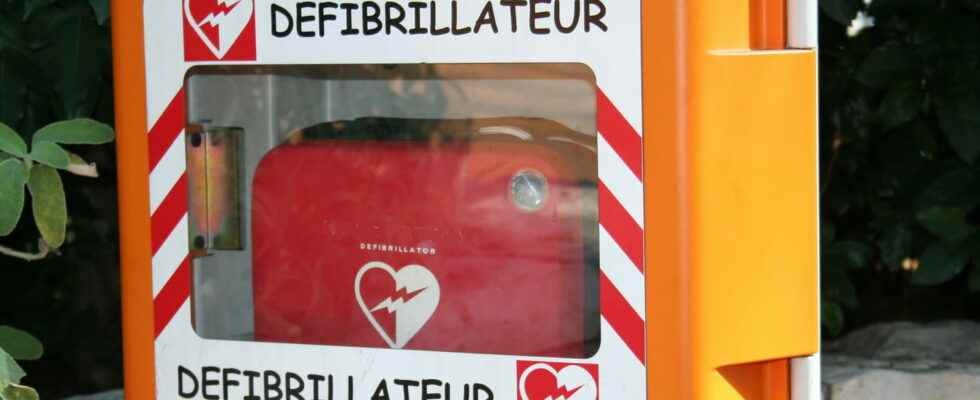A cardiac defibrillator is a medical device that helps in the resuscitation of victims of cardiac arrest. Accompanied by early chest compression, the defibrillator helps to significantly increase the chances of survival. We take stock with Professor Savary.
Definition: what is a cardiac defibrillator?
“The cardiac defibrillator is a device whose primary function is to detect and correct arrhythmias so-called “fibrillation” occurring in the ventricles of the heart“, explains Professor Dominique Savary, head of the Emergency Medicine department at the University Hospital of Angers. He will give an electric shock to defibrillate the heart, and restore his coordination by returning him to normal sinus rhythm. The apparatus consists of a box and electric wires like a pacemaker plus, a capacitor (energy accumulator). “A defibrillator also accompanies its user to perform resuscitation gestures. An audio recording delivers all the actions to be carried out: when to start chest compressions, how to do them, or place the electrodes… Some defibrillators are directly connected to a rescue center (15, 18, 112) to allow a rapid alert“. Since the publication of the decree of May 4, 2007, anyone can use an automated external defibrillator or AED.
Where can I find a cardiac defibrillator?
Within the framework of law n°2018-527 of June 28, 2018, several kinds of ERP (establishment open to the public) are legally obliged to equip themselves with a AEDs (automated external defibrillators) to make it freely accessible, recalls the site of the Ministry of Health :
- Category 1 ERPs (from 1,5001 people), 2 (from 701 to 1,5000 people) and 3 (from 301 to 700 people) since January 1, 2020;
- Category 4 ERPs (up to 300 people) since January 1, 2021;
- certain category 5 ERPs since January 1, 2022.
Concerning category 5 ERPs that must have an automated external defibrillator, it is more specifically:
- of the host institutions for seniors and people with disabilities;
- of the establishments providing health care;
- stations;
- of the hotel-restaurants located at altitude;
- shelters being in the mountains;
- sports establishments which are closed and covered;
- and multi-purpose sports halls.
“There are also mobile applications and dedicated websites which allow you to find a cardiac defibrillator near your location“, completes the Professor. We can mention the Staying Alive and SAUV Life mobile applications. Listing AEDs in the world and in France, these applications available on Android and on the Apple Store help its user to find the 10 defibrillators closest to him within a radius of about 100 m.
“The defibrillator should only be used if the person shows signs of cardiac arrest : i.e. when a person has just collapsed or is found on the ground, unconscious and not breathing normally“, adds our interlocutor. As the site of the Red Cross :
► Turn on the AED and read the instructions given by the device. “During this time, if more than one rescuer is present, one of them should start chest compressions.”
► Bare the victim’s chest and place the electrodes on the skin according to the instructions on their packaging or on the electrodes themselves (the first must be placed on the right pectoral and the second on the left side). “If it is an automatic defibrillator, it itself emits the electric shocks necessary to restart the heart without your intervention. If, on the other hand, it is a semi-automatic defibrillator, it will be necessary to press a button to deliver the electric shocks“.
► Push the button if asked. A fully automatic defibrillator will administer the electric shock.
► Continue to follow the directions of the AED until the victim regains normal breathing or until help arrives.
► “Not all cardiac arrests require an electric shock. The defibrillator will be able to recognize them. It is therefore not a fault of the machine. You will have to continue to follow the instructions it issues.“.
► If breathing returns to normal, stop resuscitation, but do not turn off the AED and leave the pads in place on the victim’s chest. If she remains unconscious, put her on her side, in a lateral safety position.
“The only vital risk for the victim is that you do not dare to use it”
What precautions to follow with a cardiac defibrillator?
Be sure that no one touches the victim when the AED analyzes his heart rhythm. If an electric shock must be administered, ensure that everyone present is kept away from the victim and its immediate environment. “In these two situations, the defibrillator reminds you of these instructions”, insists the doctor.
What are the contraindications of a cardiac defibrillator?
“There is no no contraindication the use of a cardiac defibrillator on a patient in cardiac arrest, concludes the Professor. Do not be afraid to use a cardiac defibrillator because you will be guided through each stage of resuscitation. The only vital risk for the victim is that you don’t dare to use it.“.
Thanks to Prof. Dominique SAVARY, Head of the Department of Emergency Medicine at the University Hospital of Angers.
